-
Helping improve microbes’ ability to remediate toxic metal contamination
Naturally occurring bacteria in the Gulf of Mexico did a great job helping to clean up 2010’s huge Deepwater Horizon oil spill, but bacteria can do even heavier lifting; routinely used to help clean up toxic metals at contaminated sites, bacteria and other soil microbes are fed to boost their ability to turn soluble metals into solids that will not leech into streams or aquifers
-
-
Georgia’s Plant Vogtle reviving hopes for nuclear power in U.S.
Plant Vogtle, located in Burke County, Georgia, is one of the most watched construction projects in the world; it is currently going through a $14 billion dollar expansion, which includes the first new commercial reactors built in the United States in decades
-
-
DOE promotes small-nuclear reactors (SMRs)
South Carolina’s Savannah River Site (SRS) located in Aiken, along with the U.S. Department of Energy (DOE), have announced three partnerships to develop three small modular nuclear reactors (SMRs) at the SRS facility; SMRs produce less energy than a regular reactor, but they produce enough energy to power small cities and remote areas
-
-
Seventy-four nuclear reactors in tsunami-risk areas
Researchers have, for the first time, identified those nuclear power plants which are more vulnerable to suffering the effects of a tsunami; in total, twenty-three plants, in which there are seventy-four active nuclear reactors, are located in dangerous areas in east and southeast of Asia
-
-
Seventy-four nuclear reactors in tsunami-risk areas
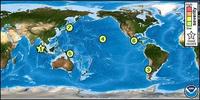
Researchers have, for the first time, identified those nuclear power plants which are more vulnerable to suffering the effects of a tsunami; in total, twenty-three plants, in which there are seventy-four active nuclear reactors, are located in dangerous areas in east and southeast of Asia
-
-
Lessons learned: Cheech and Chong at the Y-12 security breach
On 28 July 2012, an 82-year old nun and her two confederates — both senior citizens themselves – breached the vaunted and supposedly impregnable perimeter protection system at the Y-12 National Security Complex at Oak Ridge, where uranium for nuclear weapons is processed and stored (the Y-12 complex is not affiliated with the Oak Ridge National Laboratory [ORNL]); a report on the incident by the Inspector General of the Department of Energy is couched in bureaucratic jargon, but it reveals that the Y-12 security system and practices were much worse than Cheech and Chong could have ever portrayed in their wildest stand-up comedy routines or loopy films
-
-
Harvesting fuel for nuclear reactors from the sea
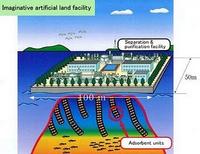
Uranium floats in Earth’s oceans in trace amounts of just 3 parts per billion. It is not much, but it adds up; combined, our oceans hold up to 4.5 billion tons of uranium — potentially enough to fuel the world’s nuclear power plants for 6,500 years; researchers propose ways to harvest this uranium
-
-
Dry-run experiments confirm key aspect of Sandia nuclear fusion concept
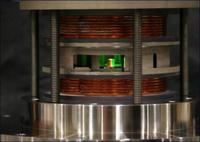
Magnetically imploded tubes called liners, intended to help produce controlled nuclear fusion at scientific “break-even” energies or better within the next few years, have functioned successfully in preliminary tests, according to researchers
-
-
Thorium to play limited role in U.K. future power supply
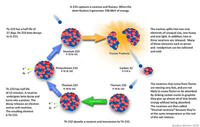
Worldwide, there has for a long time been a sustained interest in the thorium fuel cycle and presently there are several major research initiatives which are either focused specifically on the thorium fuel cycle or on systems which use thorium as the fertile seed instead of U-238; the U.K. National Nuclear Laboratory examined the topic and concluded that thorium has theoretical advantages but that these benefits are often overstated; as a result, thorium fuel cycle at best has only limited relevance to the United Kingdom as a possible alternative plutonium disposition strategy and as a possible strategic option
-
-
Nuclear waste-burning technology to make nuclear energy more appealing
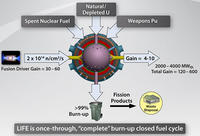
Toxic nuclear waste is stored at sites around the United States, and the need to store nuclear waste is widely considered to be a major disadvantage associated with nuclear energy; physicists have been granted a U.S. for patent for a novel fusion-fission hybrid nuclear reactor which would use nuclear fusion and fission together; the invention could drastically decrease the need for any additional or expanded geological repositories, making nuclear power cleaner and more viable
-
-
Electric plants challenged by high temperatures, drought
The hottest July on record since 1895, along with the most wide-spread drought in the country since 1956, have nuclear plants struggling with finding enough water — cool water — to keep key parts of the plants cool; if the water gets too warm, operators have to dial back production — for reactor safety, and also to regulate the temperature of discharge water, which affects aquatic life
-
-
Glass offers a better way of storing U.K. nuclear waste
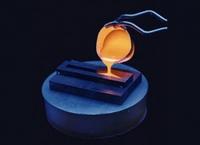
Researchers have shown, for the first time, that a method of storing nuclear waste normally used only for High Level Waste (HLW) could provide a safer, more efficient, and potentially cheaper solution for the storage and ultimate disposal of Intermediate Level Waste (ILW)
-
-
Invasion at “Fort Knox of Uranium” raises security concerns
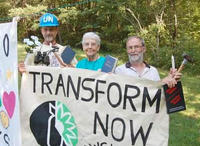
The Y-12 National Security Complex in Oak Ridge, Tennessee, is regarded asthe Fort Knox of Uranium, so the fact that three anti-nuclear activists, one of them an 82-year old nun, were able to breach the high-security complex’s protective fences is not reassuring; that they did so using nothing more than bolt cutters, after announcing their arrival from half-a-mile away, and that they could stay, undetected, in a highly secure area on the nuclear complex’s ground for two hours, is even more worrisome
-
-
Health consequences of the Fukushima disaster
The results of two studies in the 15 August issue of JAMA report on the psychological status of workers at the Fukushima nuclear power plants in Japan several months after the earthquake and tsunami in March 2011, and the amount of internal radiation exposure among residents of a city north of the power plant that experienced a meltdown
-
-
Examination of Finnish lakes reveals radiation secrets
A new study casts doubt over the validity of models used to assess the impact of radiation on human health; an examination of the affects of radioactive fallout from the 1986 Chernobyl accident on two Finnish lakes sows that the transfer of the radioactive compounds is non-linear, and that the levels of radioactive compounds appear to be three times higher in fish-eating species (piscivores) than in non-fish-eating species
-
More headlines
The long view
Smaller Nuclear Reactors Spark Renewed Interest in a Once-Shunned Energy Source
In the past two years, half the states have taken action to promote nuclear power, from creating nuclear task forces to integrating nuclear into long-term energy plans.
Keeping the Lights on with Nuclear Waste: Radiochemistry Transforms Nuclear Waste into Strategic Materials
How UNLV radiochemistry is pioneering the future of energy in the Southwest by salvaging strategic materials from nuclear dumps –and making it safe.
Model Predicts Long-Term Effects of Nuclear Waste on Underground Disposal Systems
The simulations matched results from an underground lab experiment in Switzerland, suggesting modeling could be used to validate the safety of nuclear disposal sites.
